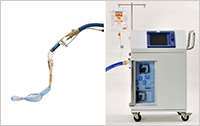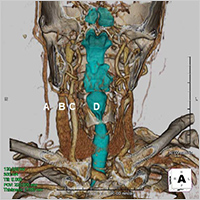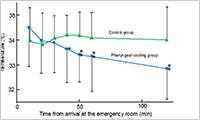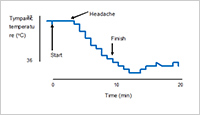The pharyngeal cooling system developed by Okayama University and Daiken Medical Co.
Enlarge Image Figure 2
3D-CT image of the human neck
A: External jugular vein, B: Internal jugular vein, C: Carotid artery,
D: Pharynx
Enlarge Image Figure 3
Changes in tympanic temperature after arrival at the emergency center. Pharyngeal cooling was initiated as soon as possible after arrival.
Enlarge Image Appendix
Changes in tympanic temperature when eating 300 g of shaved-ice treat in 10 min.
During the study, body temperature was unchanged indicating that shaved ice worked as selective brain cooling. Since brain weighs only 1400 g, 300 g of shaved ice can decrease brain temperature.
Enlarge Image
Innovation in resuscitation
In Japan in 2012, 127,000 patients were transported by ambulance owing to cardiac arrest. Ten percent of these patients were treated by witnesses to their initial cardiac arrest before the ambulance arrived. Although these patients often survived, only ten percent regained a good quality of life after their heart attack – the other ninety percent suffered varying degrees of brain damage during resuscitation. This highlights a need for innovation in resuscitation techniques in the field.
Research has shown that cooling the temperature of the brain can lessen the chances of damage during resuscitation. By cooling the blood in the carotid artery which runs near the pharynx and upper esophagus in the throat, the temperature of the brain is subsequently reduced. Researchers at Okayama University recently developed a pharyngeal cooling system (see Fig. 1) which has been evaluated in 19 emergency centers across Japan. The bilateral common carotid arteries run near the pharynx and upper esophagus (Figure 2).
The system comprises a pharyngeal cooling cuff and a circulator. The cuff is inserted into the patient’s throat, and works by circulating cold saline (5 °C) through the cuff for 2 hours. Pharyngeal cooling can be initiated before or shortly after the return of spontaneous circulation (ROSC) in the patient, without having adverse effects on ROSC or the pharyngeal epithelium. Using the pharyngeal cooling system can significantly decrease tympanic temperature (the temperature within the ear – a reflection of body and brain temperature) within 40min of arrival at an emergency center (Fig. 3). This system was approved in Japan in February 2014.
However, the existing pharyngeal cooling system was designed to be used in emergency centers, and therefore needs commercial power supply. The pharyngeal cooling cuff also needs airway protection, in the form of tracheal intubation, before it is inserted into the patient’s throat. In order to improve resuscitation in the field, the same team is now developing a transportable pharyngeal cooling system. The airway will be protected by a newly designed pharyngeal cooling cuff, and circulator will be operated by a battery power supply. With this system, physicians and emergency services will be able to protect the brain and airways during resuscitation, allowing successful cerebro-cardio-pulmonary resuscitation in the field.
★Contact: Mototaka Senda, Ph.D.,US & EU Representative of Intellectual Property Office,
Okayama University, 2450 Peralta Blvd. #119, Fremont,
CA 94536, USA
Email: takasenda@okayama-u.ac.jp




